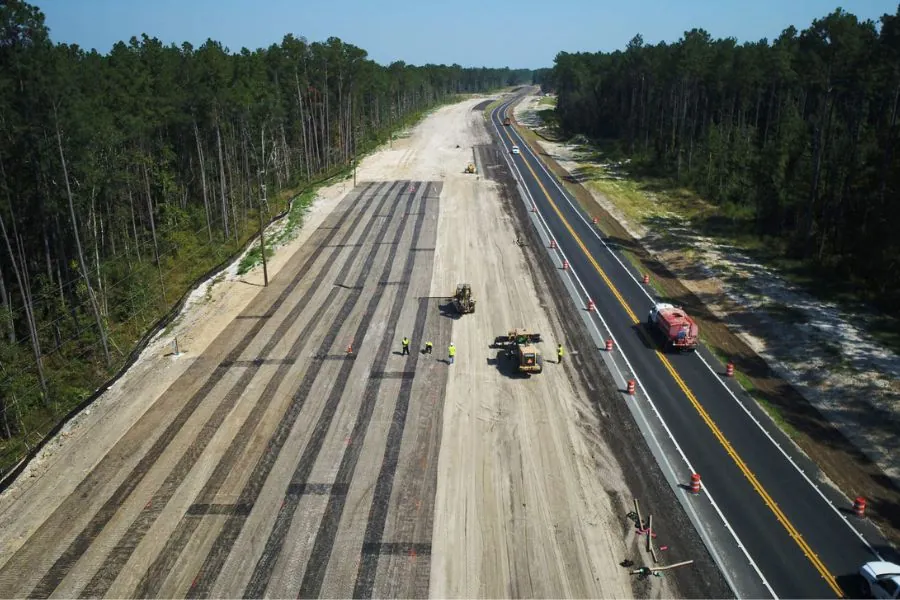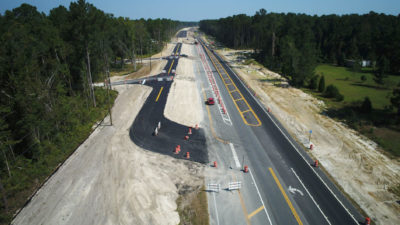RS&H Performing CEI Services on Sensitive Panhandle Project

U.S. 319 provides the most direct path for travelers heading to the small beach towns on the Florida Panhandle’s Gulf Coast from the state’s capital of Tallahassee. The current two-lane highway shoots through farmland and forests and the growing city of Crawfordville, passing close by the deep waters of Wakulla Springs.
Work is well underway to expand the highway to four lanes – part of the latest Florida Department of Transportation (FDOT) District Three project, which involves widening 2.2 miles of U.S. 319 from north of State Road 267 to the Leon County Line in Wakulla County. RS&H is serving as the prime construction engineering and inspection (CEI) firm on the project, tasked with ensuring the contractor, Anderson Columbia, abides by measures to reduce environmental contamination during construction.
The project goes much further than just widening the existing roadway. Components include reconstruction, curb and gutter, sign updates, surcharged embankments with up to 6-foot-high embankment fill sections and the construction of six stormwater ponds with over 11,000 linear feet of drainage pipe, settlement monitoring, trail parking and trailhead improvements for the Wakulla Springs State Park, and thermoplastic pavement markings.
Preserving a Sensitive, Historic Ecosystem
The delicate ecosystem of Wakulla Springs – not to mention their place in Florida history – make environmental concerns a top priority of the project. The springs have attracted tourists from across the world, as glass bottom boats giving passengers remarkable underwater views have been part of the springs’ history as far back as 1875. In fact, the springs’ incredible water clarity aided the recovery of a complete mastodon skeleton that remains on display at the Museum of Florida History in Tallahassee. Adding to the Old Florida beauty, Wakulla Springs State Park also features more than 80 connecting sinkholes and cave systems, streams, and karst windows into the aquifer.
But today, the springs are suffering. While the river boat tours at the state park among bald cypress trees, wading birds and unpredictable alligators continue to be one of the most visited tourist attractions in the area, the glass bottom boat tours over the spring basin have become as rare as a clear-water day.
The ecosystems have been degraded as native aquatic plants have been replaced by dense massive algae. The Florida Department of Environmental Protection has determined that nitrates from wastewater to the Woodville Karst Plain has been the culprit in water clarity issues.
Due to the environmentally sensitive nature of the project, there are several restrictions on which construction methods and procedures are permitted to be performed – going well beyond the prohibition of fertilizer. Since there is an increased likelihood for sink holes to develop within the project limits, the use of vibratory equipment is restricted to static mode only for compaction efforts.
“Fortunately, we have a lot of good soil material here and haven’t had to use any vibratory methods,” said RS&H CEI Project Administrator Lee Brueckheimer. “The soil here is sandy, which helps when it rains – the water is soaked right up. Plus, it’s relatively flat terrain so you’re not dealing with a lot of washouts.”
New Technologies Aid Efforts
In the area adjacent to the one-mile perpetual easement, which is the Wakulla Springs State Park’s right-of-way, surcharge embankment operations will consist of the placement of geosynthetic reinforcement fabric and settlement monitoring systems to identify any vertical settlement within the roadway template.

“If settling occurs, sensors sense a change of atmospheric pressure, and that information is immediately uploaded onto the server,” said RS&H CEI Senior Inspector Byron Caudill. “You can see changes that occur in real time.
“It’s a brand-new technology, and there have been kinks to work through to get to the starting blocks. Now, everything is working as it should.”
Partnering with the Park
RS&H has worked closely with the Florida Parks system to construct a trailhead for Wakulla Springs, as well as a new parking area off C.J. Spears Road. The team used recycled concrete and geosynthetic fabric and cut a trail that winds back into the State Park circling through many of the sinkholes, finishing the trail before peak tourist season.
As for the U.S. 319 widening, this second leg of construction is scheduled to wrap up in the spring of 2021.
Having worked on numerous projects together, RS&H Senior Project Engineer Tony Manos and Brueckheimer have a proven track record of delivering only products of the highest quality to their clients. They are supported on this project by Caudill and other RS&H staff, including Jordan Galloso, Cody Parham, and Jacob Bell, along with Amanda Hopkins from Quest Corporation of America.
“The project team has been great at working together to come up with viable, constructible solutions without losing time or incurring a lot of extra costs,” Brueckheimer said. “Everyone has the same attitude: Let’s get this project done right.”